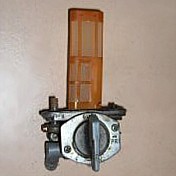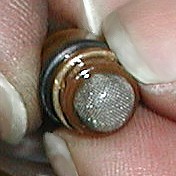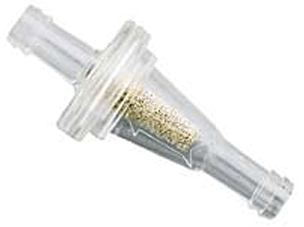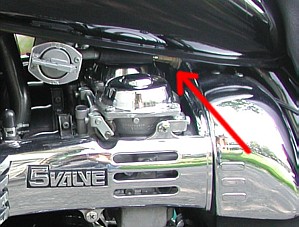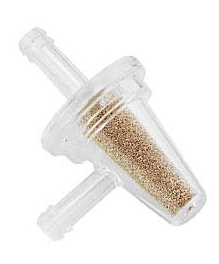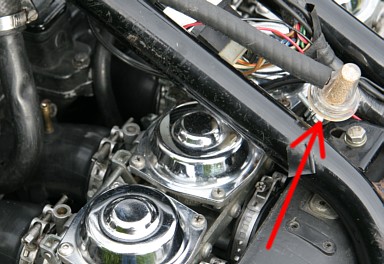|
Maxim-X Fuel Filter |
||||||||||||||||||||||||||||||||||||||
|
Unfortunately, after more than two decades of use, multiple owners and potentially repeated carburetor service, the two aforementioned forms of filtration are no longer reliable for a variety of reasons. The petcock fuel inlet mesh is expected to be the first line of defense against fuel particulates but meshes often fall off and are found floating in the fuel tank rather than filtering the fuel. They've also been known to become damaged when servicing petcocks, after which they're usually discarded. And, when derusting or otherwise treating fuel tanks, the inlet meshes are often deliberately removed and not replaced by people who've decided to rely on the float valve screens further down the line. Whatever the reasons, a large number of XJs no longer have the fuel inlet meshes or any other form of filtration inside the fuel tank. The float valve filtration screens are usually expected to be the final line of defense against fuel particulates but they too cannot be relied upon for fuel filtration. When carburetors are serviced, float valves are often replaced but rarely with float screens attached. The screens just aren't that easy to source any longer. It may also not be possible to install the original screens on new float valves whether you want to or not. Even when the stock float valves are used, it's quite easy to break or lose the float screens when trying to remove them for cleaning. After breaking or losing float screens, some XJ owners have been know to install only the screens that are left. Whatever the reasons, many XJ carburetors no longer have some or all of the float screens installed on their corresponding float valves. You could proceed on the *assumption* that both the inlet mesh and the float screens are still installed and functioning but that wouldn't be wise since the likelihood is that you don't have the full filtration that you're counting on. Even if your float screens were still present and intact and you decided to rely on them for fuel filtration, you'd be making a mistake. Over a period of two decades, the inner surface of the fuel tank will have corroded to some degree, creating debris in the fuel system which would be filtered by the float screens. You'd have a similar end result simply by buying fuel since the filtration at gas stations can also fail, allowing particulates to enter the fuel stream and ultimately to come to rest on the float screens as well. When enough debris gathers on the float screens, fuel to the carburetors can be starved off... and it often is. From every perspective, it is critical to install a fuel filter between the petcock and the carburetors. It doesn't matter whether you believe the original filtration methods are intact or not, a fuel filter will prevent any debris from reaching the carburetors and potentially doing harm. I recommend installing a small, transparent, tapered fuel filter with either a stone or bronze metal fibre filtration core. The small size and tapered construction helps prevent the formation of air pockets in the filter which could lead to vapour lock and consequently fuel starvation. The transparent construction sometimes** makes it easy to see whether the filter needs replacing. And, stone or bronze metal fibre filtration cores are effective, last longer and don't get plugged as easily as some plastic or steel screen filters. For the Maxim-X, it's especially easy to install a "Visu" straight filter directly behind the petcock as shown in the following pictures:
Some Maxim-X owners have also been known to install a 90-degree "Visu-90" filter under the fuel tank, somewhere near the midpoint of the carburetors as shown in the following pictures:
Obviously, either installation will work, however, to check or replace the Visu-90 filter, it's necessary to remove the fuel tank. In contrast, the straight Visu filter can be easily checked visually and can also be replaced without the need to remove the fuel tank. For those reasons, I prefer the straight filter rather than the 90-degree filter. There's only one piece of information you need to decide whether or not to install a fuel filter on your Maxim-X - Do you see a fuel filter between the petcock and the carbs? If not, you desperately need to install one at your earliest opportunity. Trust me, it's a modification you can't afford to skip. In time, when you see how much debris gathers in the fuel filter, it should become clear why it was so important to install one. I buy Visu filters regularly and have discovered that the local Yamaha dealer is not the place to buy them. Instead, I buy mine from the local Honda dealer. Honda sells these filters for a mere CAD $4.00 +/- while Yamaha sells the very same filters for twice and often three times as much. Wherever you buy them, buy several at once to keep them on-hand and to keep one in your bike's tool kit for emergencies. **Note: Although a transparent filter often helps in discovering whether a replacement is due, it isn't always as clear as you might think (pun intended |
||||||||||||||||||||||||||||||||||||||
